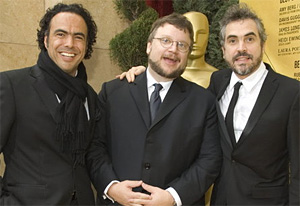 |
 |
 |
 Entertainment | June 2007 Entertainment | June 2007  
Is Everyone Doing the Cha Cha Cha?
 Daniel Holloway - Metro New York Daniel Holloway - Metro New York


| | Alejandro Gonzalez Inarritu, Alfonso Cuaron and Guillermo del Toro at the Academy Awards in Hollywood, CA in February. (A.M.P.A.S.) |
If you believe the hype, Alfonso Cuarón, Alejandro González Iñárritu and Guillermo del Toro are the harbingers of a golden age of Mexican cinema. When their films (“Children of Men,” “Babel” and “Pan’s Labyrinth,” respectively) were nominated early this year for a collective 16 Oscars, Hollywood took notice. USA Today said the three directors — or Three Amigos, as they like it — were “leading what some critics and analysts call a Mexican revolution in film.” The Chicago Tribune likened them to the French New Wave auteurs of the ’50s and ’60s.

So when the trio signed a five-film, $100 million deal in May with Universal, forming a production company called Cha Cha Cha, it looked like a testament to the strength of the Mexican film industry. Anne Thompson, deputy editor of Variety.com, says it’s rare to find filmmakers banding together to coax such a favorable deal from a major studio.

“I would say that you would have to go back to First Artists [Paul Newman, Barbra Streisand, Sidney Poitier, Steve McQueen and Dustin Hoffman],” she says. “And it was not a success.”

But according to David William Foster, author of “Mexico City in Contemporary Mexican Cinema,” Mexico isn’t sharing in the Three Amigos’ success.

“One of the points that was made over and over again in the stories about these three blockbusters — ‘Babel,’ ‘Pan’s Labyrinth’ and ‘Children of Men’ — was about why these films were made outside of Mexico,” he says. “Now, all of a sudden, you have three major Mexican directors working outside of Mexico.”

Foster describes a Mexican film industry that once thrived under Hollywood’s stewardship. Prior to the ’60s, U.S. studios owned the bulk of Mexico’s distribution networks and theaters. Though the system was established to promote American films, it also provided quality venues in which Mexican audiences could see domestic movies.

According to Foster, diminished investment on the part of U.S. studios and Mexico’s government has crippled the film industry south of the border, making successful, native-produced films such as 2000’s “Amores perros” and the rise of stars such as Gael García Bernal exceptions to the norm. The result: The Cha Cha Cha films may be Mexican-flavored, but they likely won’t be made in Mexico.

“It seems clear to me they’re going to make films that are going to appeal to an American blockbuster audience,” Foster says. “They’re not going to build a mainstream of Mexican film production.”

Diego Luna is Bernal’s business partner and co-star in the 2001 Cuarón film “Y tu mamá también.” Luna’s directorial debut, “J.C. Chávez,” a documentary about the Mexican boxing champion, premiered in April at the Tribeca Film Festival.

Though he recognizes the primacy of the U.S. market, he also stresses the significance of looking beyond it.

“It’s important, because there’s a huge business in the States,” he says. “It is important for the business and for the industry. But the most important thing is to realize that films should be international. Films should just be films and travel around the world, because every story can have an impact.” | 
 | |
 |



